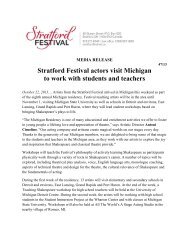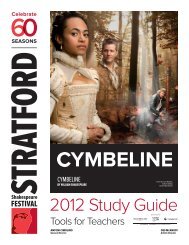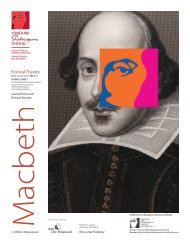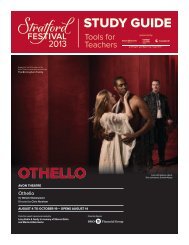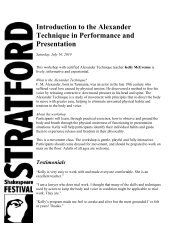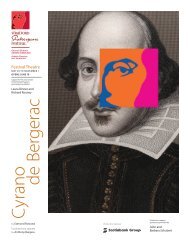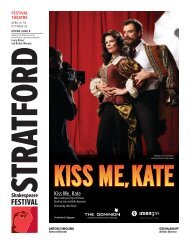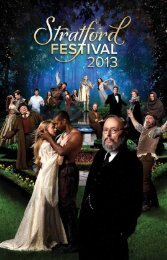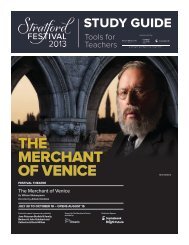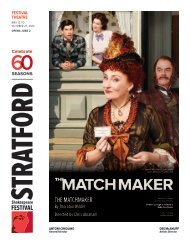THE THREE MUSKETEERS - Stratford Festival
THE THREE MUSKETEERS - Stratford Festival
THE THREE MUSKETEERS - Stratford Festival
- No tags were found...
You also want an ePaper? Increase the reach of your titles
YUMPU automatically turns print PDFs into web optimized ePapers that Google loves.
STUDY GUIDETools forTeacherssponsored by<strong>THE</strong> <strong>THREE</strong><strong>MUSKETEERS</strong>From left: Jonathan Goad,Luke Humphrey, Graham Abbey,Mike SharaFESTIVAL <strong>THE</strong>ATRESchulich Children’s Plays presentsThe Three MusketeersBy Peter Raby | Adapted from the novel by Alexandre DumasDirected by Miles PotterMAY 18 TO OCTOBER 19 – OPENS JUNE 1
Table of ContentsThe PlaceThe <strong>Stratford</strong> Story ...................................................................................................... 1The PlayThe Author: Alexandre Dumas .................................................................................... 3Characters in the Play ................................................................................................. 4Plot Synopsis ............................................................................................................... 5BackgroundSeventeenth-Century France – A Few Fun Facts ....................................................... 6Historical Counterparts ................................................................................................ 7Glossary ........................................................................................................................ 9The ProductionCast and Artistic Team ............................................................................................... 10Lesson Plans and ActivitiesMap the Musketeers ........................................................................................... 12Stage Combat – Storytelling ................................................................................ 13Dumas’ Adventure Story Studio ......................................................................... 14Discussion Topics ............................................................................................... 15Resources ..................................................................................................... 16
The<strong>Stratford</strong>StoryThat <strong>Stratford</strong>, Ontario, is the home ofthe largest classical repertory theatrein North America is ultimatelyattributable to the dream of one man,<strong>Stratford</strong>-born journalist TomPatterson.In the early 1950s, seeing theeconomy of his home townendangered by the withdrawal of therailway industry that had sustained itfor nearly 80 years, Pattersonconceived the idea of a theatre festivaldevoted to the works of WilliamShakespeare. His vision won thesupport not only of <strong>Stratford</strong> CityCouncil and an enthusiastic committeeof citizens, but also of the legendaryBritish actor and director TyroneGuthrie, who agreed to become theproposed festival’s first ArtisticDirector. The <strong>Stratford</strong> Shakespearean<strong>Festival</strong> of Canada was incorporatedas a legal entity on October 31, 1952.A giant canvas tent was ordered from afirm in Chicago, and in the parklandsby <strong>Stratford</strong>’s Avon River work beganon a concrete amphitheatre at thecentre of which was to be arevolutionary thrust stage created toGuthrie’s specifications byinternationally renowned theatricaldesigner Tanya Moiseiwitsch.discontent/ Made glorious summer bythis sun of York.” Those words markedthe triumphant end to what hadsometimes seemed a hopelessstruggle against the odds to turnPatterson’s dream into a reality – andthe beginning of an astonishing newchapter in Canadian theatre history.The other production of that inauguralsix-week season, a modern-dressversion of All’s Well That Ends Well,opened the following night, confirmingthe opinion of celebrated novelistRobertson Davies that the new <strong>Festival</strong>was an achievement “of historicimportance not only in Canada, butwherever theatre is taken seriously –that is to say, in every civilized countryin the world.”Time proved the truth of Davies’words, for the <strong>Festival</strong>’s pillared,porticoed thrust stage revolutionizedthe performance of classical andcontemporary theatre in the latter halfof the 20th century and inspired thedesign of more than a dozen othermajor venues around the world,including the Guthrie Theatre inMinneapolis, the Beaumont Theatre atLincoln Centre and, in England, theChichester <strong>Festival</strong> Theatre, theCrucible Theatre in Sheffield and theOlivier Theatre at the Royal NationalTheatre in London. Over the years, the<strong>Festival</strong> has made some amendmentsto the original design of Moiseiwitsch’sstage, without changing its essentialformat.From the balcony of that stage, on thenight of July 13, 1953, actor AlecGuinness spoke the opening lines ofRichard III: “Now is the winter of ourThe Three MusketeersStudy Guide<strong>Stratford</strong> <strong>Festival</strong> 2013 1
The Author:Alexandre DumasAlexandre Dumas (1802–1870) was aFrench writer most famous for historicalnovels such as The Three Musketeersand The Count of Monte Cristo. Born in asmall French village in 1802, Dumaswas the son of a French military generalwho had served under Napoleon, and aninnkeeper’s daughter. Dumas’ father fellout of favour with Napoleon and by thetime Dumas was born, the family hadbecome impoverished. Dumas’ fatherdied in 1806 when the young boy wasonly four. His mother did her very best toensure that her son received aneducation. She regaled him with storiesof his father’s bravery, which fueled histaste for tales of adventure, and he readabsolutely everything he could get hishands on.Although poor, Dumas had his father’snoble pedigree in his favour and, afterthe restoration of the monarchy, he setoff in 1822 for Paris, where he securedhimself a position at the Palais Royal inthe office of Louis-Philippe, Duke ofOrléans. While working in Paris, Dumasbegan writing articles for magazines andplays for the theatre. His first two playswere very successful and allowed him towork full-time as a writer. He soonswitched his focus to novels. His firstnovel was one of his plays, Le CapitainePaul, re-written in serial form (whichearned him a great deal of money foreach installment). Soon, he had foundeda production studio staffed with writerswho churned out hundreds of stories.Dumas himself collaborated with manyof them on his own stories. AugustMaquet is the most well-known of hiscollaborators and aided him with bothThe Count of Monte Cristo and TheThree Musketeers.Dumas earned a great deal of moneyfrom his writing but spent even more. Hewas fond of sumptuous living and wasoften dodging creditors. He married theactress Ida Ferrier in 1840, but it doesnot seem to have been a happymarriage. Instead, Dumas is rumouredto have had more than 40 mistressesand several illegitimate children(including his first-born son, AlexandreDumas (fils), son of Marie-LaureCatherine Labay). He died in France in1870. He is honoured in France to thisday with a monument standing in hismemory and a metro station bearing hisname; his house has been restored andis open to the public. His storiescontinue to entertain and inspire peoplefrom around the world and havespawned numerous television and filmadaptations.The Three MusketeersStudy Guide<strong>Stratford</strong> <strong>Festival</strong> 2013 3
Characters in the Play(in order of appearance)D’Artagnan’s FatherD’ArtagnanD’Artagnan’s MotherHis NurseFamily PriestInnkeeper of The Jolly MillerInnkeeper’s WifeRochefort, The Cardinal’s AgentBicarat Officers of the Cardinal’s GuardsJussacMilady De WinterMme. Coquenard, in love with PorthosBonacieux, a grocer, Husband of ConstanceCoquenard, Husband of Mme. CoquenardM. de Treville, Commander of the King’s MusketeersPorthosAramis the Three MusketeersAthosMme. De Chevreuse, in love with AramisKitty, Milady’s maidConstance, Wife of Bonacieux, lady-in-waiting to the QueenDuke of BuckinghamLouis XIII, King of FranceAnne of Austria, Queen of FranceLaport, the Queen’s valetDona Estefania, lady-in-waiting to the Queen, the Cardinal’s informantGrimaud, servant to AthosPlanchet, servant to D’ArtagnanCardinal RichelieuChantilly InnkeeperLandlady of the Gilded LilyA Sea CaptainLe Comte De WardesPatrick, servant to BuckinghamMr. O’Reilley, Buckingham’s jewellerLandlady at CrevecoeurA JesuitA CuréLord de Winter, brother-in-law to MiladyBrisemont, a banditAnother BanditInnkeeper at the Red DovecotFelton, a PuritanAbbess of the Convent at BethuneExecutionerThe Three MusketeersStudy Guide<strong>Stratford</strong> <strong>Festival</strong> 2013 4
Plot SynopsisAn adventurous youth, D’Artagnan, leaves his home in Gascony for Paris, hoping to jointhe Musketeers of King Louis XIII. No sooner is he accepted as a cadet than he becomesinvolved in separate duels with three leading Musketeers: Athos, Porthos and Aramis.When the rival guards of Cardinal Richelieu try to arrest the duellists, D’Artagnan joinshis three opponents in fighting them off, and the four vow eternal friendship. Meanwhile,Richelieu, with the help of the beautiful but dangerous Milady de Winter, seeks toexpose a liaison between Queen Anne and an English nobleman, the Duke ofBuckingham. The Musketeers are sent to London to retrieve some incriminatingdiamonds that Anne has given to Buckingham – a mission that is accomplished byD’Artagnan alone, after his comrades are wounded. D’Artagnan subsequently discoversthat Milady is the former wife of Athos, who believed her to be dead. Milady fails in twoattempts to kill D’Artagnan, but succeeds in contriving the deaths of Buckingham andthe go-between Constance, before she is captured and brought to justice.For a quick cartoon version of the story, check out the <strong>Festival</strong>’s “How to Become aMusketeer” video here:http://www.stratfordfestival.ca/OnStage/productions.aspx?id=20225&prodid=47000(You can also find it by clicking on the play title on the website home page and choosing“Videos and Photos” on the left-hand side of the production page.)The Three MusketeersStudy Guide<strong>Stratford</strong> <strong>Festival</strong> 2013 5
Seventeenth-Century France – A Few Fun FactsDuring the seventeenth century, France operated under a very powerful monarch, fought in aseries of wars and fostered a great literary culture. This was a time of daring deeds, militaryvalour and intellectual growth; industrious people rose to power and notability. Paris, theFrench capital, was the centre of arts, culture and diversity of population. It was the pulse ofFrance and attracted the prestigious and the elite and dictated fashion and customs.Gossip, particularly at court, was rampant, as was intrigue. All this intrigue was facilitated bythe fact that Paris was totally dark at night, as street lighting did not come into effect until1662.During this period, the French became known for their bravado:“Never fear quarrels, but seek hazardous adventures. Fight on all occasions; fight themore for duels being forbidden, since, consequently, there is twice as much couragein fighting.” – Alexandre Dumas, The Three MusketeersFrench noblemen carried swords at all times, and were always willing to defend slightsagainst their honour. Even the most pathetic quibble resulted in a challenge or duel. Duelswere carried out as a statement of honour.Bathing was an irregular practice – potpourri and perfumes masked the smell of unwashedbodies. City life was very dirty and crowded. Cow pastures, hen houses and vineyards werelocated within the city as well as in the rural areas. Epidemics of plague, typhus, typhoid,smallpox and influenza regularly killed significant portions of the population. Theseepidemics spread more rapidly in the city than in the less populated and more spread-outrural areas, yet the majority of deaths were among the peasants. In addition, pooragricultural techniques, inclement weather and war regularly caused crop failures andcreated shortages of food. Many peasant farmers could not support their families. Hightaxes imposed by the king also caused a massive outcry amongst the peasant class.Life in seventeenth-century France was dark, dangerous and dirty!Victor Ertmanis, the actor playing M. de Treville in this season’s production of The ThreeMusketeers, took a research trip to Paris to prepare for his role. He visited the Parisneighbourhoods where D’Artagnan, Athos, Porthos and Aramis have their adventures anddocumented his journey online. For a guided tour of the “Musketeers in Paris” visit Mr.Ertmanis’s website at www.victorertmanis.com.The Three MusketeersStudy Guide<strong>Stratford</strong> <strong>Festival</strong> 2013 6
Historical CounterpartsMany of the characters in The Three Musketeers are based on actual historical figures –although Dumas and his collaborator, August Maquet, invented the situations thesecharacters find themselves in in the novel.D’Artagnan, the hero of the story, is based on the life of Charles de Batz-Castelmore, whodid, indeed, hail from the Gascon region of France. He adopted the name of Sieur ofArtagnan from a family property. He came to Paris seeking to serve the king rather laterthan in 1625 as in the novel. He served Louis XIV and Mazarin rather than theirpredecessors, Louis XIII and Richelieu. He rose through the ranks to great distinction,becoming Captain of the Musketeers, and died in service in 1673 at the Siege ofMaestricht.The Three Musketeers, Athos, Porthos and Aramis, are also based on real Musketeers.Porthos is based on Isaac de Porthau, a member of the Musketeers, who was alsorelated to both M. de Treville and Athos. Athos was based on Armand de Sillegue d’Athos.He was de Treville’s nephew and, as mentioned, also related to Isaac de Porthau. Henrid’Aramitz was another Musketeer, also related to de Porthau and de Sillegue d’Athosthrough his uncle, de Treville.Monsieur de Treville, the man linking all three Musketeers and known to D’Artagnan, wasbased on the historical Jean-Armand du Peyrer, compte de Troisville (or Treville). AGascon born in Oloron-Sainte-Marie, du Peyrer was the son of an old military familyennobled only in 1607 by the purchase of a seigneurie (Trois Villes) He entered the royalarmy as a young cadet, and by dint of his great skill as a soldier, a duelist and a courtier,became commander of the king’s Musketeers in 1624. During his captaincy, he recruitedmany of his relatives (see above) as Musketeers.King Louis XIII ruled France from 1610 (upon the assassination of his father, Henry IV)until his death in 1643. He married Anne of Austria, daughter of King Phillip III of Spain,in 1615 when they were both 14 years old. It was not a happy marriage, however it didproduce a son: the future Louis XIV. Louis XIII ruled France, initially with the unwantedhelp of his mother, Marie de Medici, and later, with the trusted help of his chief ministerand right hand man, Cardinal Richelieu.Queen Anne of Austria was the daughter of King Phillip III of Spain and Margaret ofAustria. She was married to Louis XIII of France when they were both 14 years old. Thecouple did not have their first child, Louis XIV, until Anne was 37. Cardinal Richelieu’s warwith the Hapsburgs (from whom Anne was descended) and Louis’ declaration of war onSpain in 1635 certainly put Anne in an impossible position and put a strain on theirmarriage. She was generally considered to be brilliant, cunning and beautiful (her handsespecially), with a love for magnificent jewellery. She became Queen Regent upon thedeath of Louis XIII until their son came of age in 1651.Cardinal Richelieu (Armand Jean du Plessis) was a French clergyman, nobleman andstatesman. He was born in Paris on September 9, 1585. He took the name Richelieufrom the name of his family's estate. In 1606 he was appointed Bishop of Luçon, and in1622 he became a Cardinal. Richelieu rose from his provincial post in Luçon to becomeFrance's Secretary of State for foreign affairs in 1616. He then became France’s primeThe Three MusketeersStudy Guide<strong>Stratford</strong> <strong>Festival</strong> 2013 7
minister and head of the royal council in 1624. Richelieu was successful in helping KingLouis XIII solidify his authority in France – which he did through force and politicalrepression. By 1631, Richelieu had crushed Huguenot resistance, severely punishednobles who plotted against the king and replaced his enemies in the government. Duringhis service as prime minister he helped France become the leading power in Europe. Inaddition, Richelieu rebuilt the Sorbonne in Paris, supported promising writers andfounded the French Academy. Many French historians consider Richelieu the founder ofa unified France, as well as the person who released France from its medieval nature.The Three MusketeersStudy Guide<strong>Stratford</strong> <strong>Festival</strong> 2013 8
GlossaryCharlemagne (April 2, 742 – January 28, 814) was also known as Charles the Great or Charles I.He was the King of the Franks from 768, the King of Italy from 774, the first Holy RomanEmperor and the first emperor in western Europe since the collapse of the Roman Empire threecenturies earlier.Don Quixote: The title character in Miguel de Cervantes’ novel of the same name. In the novel, acountry gentleman, Alonso Quijano, adopts the name Don Quixote in the guise of his alter ego asa knight errant, determined to restore chivalry to the world.Rosinante: Don Quixote’s horse (see above); also used to generally refer to a worn-out, brokendownold horse, or nag.Gascon: A person from the region of Gascony in France. Gascony was known for its “sweet life,”good food, sunny weather and beautiful landscapes. Gascons were known to be big, brash, boldand full of bravado (although the Parisians considered them uncultured and ill-mannered).Chevalier: Knight.The Louvre: France’s official royal palace and home to its monarchs until Louis XIV built Versaillesin 1684.Vivat: Latin word meaning “to live.” It is usually used to salute someone, as in, “Long life!” or“Long live the king!”Tyburn: A village in England famous for hangings and known as the seat of capital punishment. A“Tyburn tree” is a gallows.Monsieur: Mr.Monseigneur: My lord.Mademoiselle: Miss.Madame: Mrs.Denier, sou livre, ecu, pistole, Louis d’or: Units of French currencyRue: Street.Place: Square.Pont: Bridge.Porte: Gate.Faubourg: Suburb or quarter/area on the outskirts of town.The Bastille: A famous French prison.The Three MusketeersStudy Guide<strong>Stratford</strong> <strong>Festival</strong> 2013 9
Cast and Crew2013 <strong>Stratford</strong> <strong>Festival</strong> Production:<strong>Festival</strong> Theatre, May 18 to October 19, 2013Artistic TeamDirector ..........................................................Miles PotterFight Director .................................................John SteadSet Designer ..................................................Douglas ParaschukCostume Designer .........................................Gillian GallowLighting Designer ..........................................Michael WaltonComposer ......................................................Leslie ArdenSound Designer .............................................Todd CharltonCast ListD’Artagnan’s Father ......................................Wayne BestD’Artagnan ....................................................Luke HumphreyD’Artagnan’s Mother ....................................Lally CadeauHis Nurse .......................................................Shauna BlackFamily Priest ..................................................Tim MacDonaldInnkeeper of the Jolly Miller .........................Robert KingRochefort .......................................................Michael BlakeBicarat ............................................................Daniel BriereJussac ............................................................Tyrone SavageMilady de Winter ...........................................Deborah HayMme. Coquenard ..........................................Sabryn RockBonacieux ......................................................Anand RajaramM. de Treville .................................................Victor ErtmanisPorthos ...........................................................Jonathan GoadAramis ............................................................Mike SharaAthos ..............................................................Graham AbbeyMme. de Chevreuse ......................................Sophia WalkerKitty ...............................................................Shauna BlackConstance Bonacieux ...................................Bethany JillardDuke of Buckingham ....................................Skye BrandonLouis XIII, King of France ..............................Keith DinicolAnne of Austria, Queen of France ................Nehassaiu deGannesLaporte ...........................................................Tim MacDonaldDona Estefania ..............................................Sara FarbGrimaud .........................................................Andrew RobinsonPlanchet .........................................................Antoine YaredCardinal Richelieu .........................................Stephen SutcliffePatrick ............................................................Karl AngInnkeeper at Chantilly ...................................Andrew LawrieLandlady of the Gilded Lily ...........................Sophia WalkerA Sea Captain ................................................Victor ErtmanisMr. O’Reilley ..................................................Robert KingLandlady at the Black Lion ...........................Lally CadeauA Jesuit ...........................................................Tim MacDonaldLord de Winter ...............................................Wayne BestThe Three MusketeersStudy Guide<strong>Stratford</strong> <strong>Festival</strong> 2013 10
Brisemont ......................................................Ron PedersonEarl of Ormsby ...............................................Ron PedersonBandit.............................................................Robert KingInnkeeper at the Red Dovecot .....................Victor ErtmanisFelton .............................................................Gareth PotterAbbess ...........................................................Lally CadeauExecutioner ....................................................Roy LewisMusketeers: Karl Ang, Wayne Best, Skye Brandon, Tyrell Crews, Shawn DeSouza-Coelho,Thompson Duff, Andrew Lawrie, Ron Pederson, Cal Potter, Gareth Potter, AndrewRobinson, Reid Vanier, Antoine YaredCardinal’s Guards: Tyrell Crews, Thompson Duff, Roy Lewis, Cal Potter, Gareth Potter,Reid VanierOther Characters Played By: Karl Ang, Wayne Best, Shauna Black, Skye Brandon, LallyCadeau, Tyrell Crews, Shawn DeSouza-Coelho, Thompson Duff, Victor Ertmanis, SaraFarb, Robert King, Andrew Lawrie, Roy Lewis, Tim MacDonald, Ron Pederson, Cal Potter,Gareth Potter, Anand Rajaram, Andrew Robinson, Sabryn Rock, Tyrone Savage, ReidVanier, Sophia Walker, Antoine YaredFor more information and company bios visit: www.stratfordfestival.ca. Youcan also check out our <strong>Stratford</strong> for Students magazine at:http://www.stratfordfestival.ca/education/teachers.aspx?id=8609Victor Ertmanis, the actor playing M. de Treville in this season’s productionof The Three Musketeers, took a research trip to Paris to prepare for hisrole. He visited the Paris neighbourhoods where D’Artagnan, Athos, Porthosand Aramis have their adventures and documented his journey online. For aguided tour of the “Musketeers in Paris” and other fantastic tidbits relatedto The Three Musketeers, visit Mr. Ertmanis’s website atwww.victorertmanis.com.The Three MusketeersStudy Guide<strong>Stratford</strong> <strong>Festival</strong> 2013 11
Imaginative Ways to Approach the TextMap the MusketeersGrade LevelSubject Area(s)Materials andPrep.anyEnglish, History, Geography Map handoutsD’Artagnan begins his journey from Gascony (a south-western region of France) in Tarbes. Hetravels to Meung (just south-west of Orleans, between Orleans and Blois) and then to Paris. Afterhe meets up with the Musketeers, they all journey to London via Chantilly (half-way between Parisand Compiègne), Amiens, Calais and across the English Channel to Dover, returning, finally, toParis. Trace their journey on the map below.The Three MusketeersStudy Guide<strong>Stratford</strong> <strong>Festival</strong> 2013 12
Imaginative Ways to Approach the TextStage Combat - StorytellingGrade Level 8 - 12Subject Area(s) English, Drama, Phys. Ed.SpaceDesks moved aside and clear open space in the classroomMaterials andPrep. Internet connection or DVD player. Handouts of “Stage Combat” article from <strong>Stratford</strong> for StudentsConvincing and exciting fight sequences, both on film and in the theatre, look spontaneous butare painstakingly rehearsed by professionals. Some of the best fight director/choreographers forfilm are Jackie Chan and George Marshall Ruge. With today’s technology, however, movie fightsequences all incorporate digital technology and editing to enhance the scenes. One of the verybest fight directors in the world for theatre is the <strong>Stratford</strong> <strong>Festival</strong>’s John Stead. He must createconvincing fight sequences, that help tell the story, without any movie “magic” or editingsoftware.Setting up the exercise: Have the students watch the opening fight scene between Jack and Will from Pirates ofthe Caribbean: The Curse of the Black Pearl (choreographed by Ruge) and the bar fightscene from Shanghai Noon (choreographed by Jackie Chan). (You can find the clips onYouTube or on the DVDs of the films.)Next, as a class, read the article “Stage Combat” from <strong>Stratford</strong> for Students(www.stratfordfestival.ca/education/teachers.aspx?id=8609). This will give students anunderstanding of John Stead’s approach to staging fight sequences at the <strong>Festival</strong>, fortheatre in general and The Three Musketeers in particular.In groups of 3, have students write a simple 2-minute fight scene with storytellingelements. The plot must be clear and easy to understand: Setting, Protagonist v.Antagonist, Conflict, Resolution. For example:Title: “The War of the Brides”Setting: Bridal shopProtagonist: Bride-to-be #1Antagonist: Bride-to-be #2Conflict: Fight over the same dressResolution: They rip the dress in half, so the shop assistant sellsthe dress half-price to them both.Have the students plan the fight with this simple table:Movement Action/Item Actor A Actor B Dialogue1 Wedding dress Pulls at dress Pulls back “Let go!”2 Lets go “That’ll teachyou!”3 Falls on ground4 Leaps on top of AHave the students rehearse the scene slowly, building skills and momentum. Ask thestudents to perform the scene for the class and grade the performance using a rubric.Extension: Follow up this lesson with a professional stage combat workshop at the <strong>Stratford</strong><strong>Festival</strong>.The Three MusketeersStudy Guide<strong>Stratford</strong> <strong>Festival</strong> 2013 13
Imaginative Ways to Approach the TextDumas’ Adventure Story Studio 1Grade Level 8 - 10Subject Area(s) English, DramaLiteracy Strand WritingSetting up the activity:Dumas had such success producing serial novels that he soon set up a production studio dedicated to thegenre, staffed with many writers who could help him churn out stories as quickly as the public devouredthem. The novels generally dealt with bravery, patriotism and adventure and contained large battleswherein the heroes defended both country and honour. In addition, the stories contained an element ofhistory and usually included a romantic entanglement for the main character(s) amidst all theswashbuckling and high adventure of the central plot. The Pirates of the Caribbean is a good modernexample of the type of stories and novels produced by Dumas and his staff of writers.The Activity:Students will need some paper and a pen or pencil (or keyboard). Students will write continuously for theentire period, creating an adventurous tale of bravery and intrigue. The story must contain: A ruling royal personage (King, Queen, Emperor, etc.) A lovable hero A love interest for the hero A dastardly villain set to bring down the ruler An important object An exotic setting A historical occurrence or personThis is a free-write and it is important that the students write continuously for the entire time. If they getstuck you may give them prompts (i.e. words they must incorporate in their next few sentences). Encouragethem to focus on the structure of the story and use vivid descriptions. Make sure they have clearly defined: Characters (identify the protagonist and antagonist) Setting Conflict Complication(s) Climax ResolutionAdaptation: This lesson could be used in a drama classroom as improvised story-telling instead of writing.1 Adapted from an activity created by Joy-lee Parasiers.The Three MusketeersStudy Guide<strong>Stratford</strong> <strong>Festival</strong> 2013 14
Discussion Topics for Your ClassBefore Viewing The Three Musketeers:1. What do you expect to see on stage at the <strong>Stratford</strong> <strong>Festival</strong>? Have each student makea list of predictions about what they expect. Save these predictions. After your <strong>Stratford</strong>trip, revisit them to see how they compared to the actual production.2. Why do you think this story has held such appeal for so many years?3. Compare Dumas’ presentation of the characters with their historical counterparts andhis plot with historical events. What changes did he make and why?4. Friendship is a huge theme in The Three Musketeers as is the motto “All for one andone for all.” Have students recall and discuss instances where they accomplishedsomething only through teamwork (that they were unable to accomplish on their own).5. Pride also figures largely in the play. D’Artagnan and the Three Musketeers are knownfor their Gascon pride and are mocked by the Parisians. Discuss positive examples ofpride and also the negative effects of pride.After your <strong>Stratford</strong> trip:1. Consider that The Three Musketeers was originally a lengthy novel. How successfulwas the writer, Peter Raby, in adapting it to the stage? What might have been thechallenges and how were they solved in either the adaptation or the staging?3. What parts did you respond to most while watching The Three Musketeers? Why?4. Were there parts you wished were different? How?5. If you were one of the writers in Dumas’ historical-action-adventure writing productionstudio, who and when would you write about?6. Write a critical review of the play giving full consideration to both the technical andperformance aspects of the production. Your review should provide a detailed descriptionand analysis of the production that support your overall opinion of the performance andshould be supported with specific examples from the play.For more classroom activities, complete with instructions, materials and Ontariocurriculum expectation links, visit stratfordfestival.ca/teachingmaterials. You can alsocheck out the following:The Forum, a series of remarkable events to enrich the play-going experience:www.stratfordfestival.ca/forum/ .<strong>Stratford</strong> <strong>Festival</strong>’s YouTube channel for behind-the-scenes videos, photos andinterviews: www.youtube.com/user/stratfordfestival<strong>Stratford</strong> <strong>Festival</strong>’s Flickr pages: www.flickr.com/photos/stratfest/<strong>Stratford</strong> <strong>Festival</strong> Twitter: twitter.com/stratfest<strong>Stratford</strong> <strong>Festival</strong> Facebook: www.facebook.com/<strong>Stratford</strong><strong>Festival</strong><strong>Stratford</strong> <strong>Festival</strong> Behind the Scenes App.: www.stratfordfestival.ca/explore.The Three MusketeersStudy Guide<strong>Stratford</strong> <strong>Festival</strong> 2013 15
ResourcesBOOKDumas, Alexandre. The Three Musketeers. 1844E-BOOKProject Gutenberg: http://www.gutenberg.org/ebooks/1257Penn State University: http://www2.hn.psu.edu/faculty/jmanis/dumas/3musk1.pdfONLINE RESOURCESThe Three Musketeers at <strong>Stratford</strong>, an actor’s research, blog and journey:www.victorertmanis.comDumas, Life and Timeswww.en.wikipedia.org/wiki/Alexandre_Dumaswww.online-literature.com/dumaswww.centerstage.org/cyrano/Digital-Dramaturgy/Glimpses-of-17thcentury-France.aspxHistory, France and Pariswww.travour.com/tours-to-france/culture-of-france/architecture-of-france.htmlwww.paris-in-photos.com/paris-photos/oldparis030.htmlThe Three Musketeers ON FILM, VIDEO AND DVD1948 (US) The Three Musketeers. Directed by George Sydney, Starring: Gene Kelly,Lana Turner, Angela Lansbury and June Allyson1973 (US) The Three Musketeers. Directed by Richard Lester, Starring: Oliver Reed, RichardChamberlain, Rachel Welch, Michael York, Charlton Heston, Christopher Lee and FayeDunaway1993 (US) The Three Musketeers. Director by Stephen Herek, Starring: Charlie Sheen, KieferSutherland, Chris O’Donnell, Rebecca De Mornay and Julie Delpy2001 (US) The Musketeer. Directed by Peter Hyams. Starring: Justin Chambers, Mena Suvari, TimRoth and Catherine Deneuve.2011 (Germany/France/UK/US) The Three Musketeers. Directed by Paul W S Anderson. Starring:Matthew Macfadyen, Orlando Bloom, Ray Stevenson and Milla Jojovich.Connect with <strong>Stratford</strong>: For further exploration and interactive activities check out the following:The Forum, a series of remarkable events to enrich the play-going experience:http://www.stratfordfestival.ca/forum/ .<strong>Stratford</strong> <strong>Festival</strong>’s YouTube channel for behind-the-scenes videos, photos andinterviews: http://www.youtube.com/user/stratfordfestival<strong>Stratford</strong> <strong>Festival</strong>’s Flickr pages: http://www.flickr.com/photos/stratfest/<strong>Stratford</strong> <strong>Festival</strong> Twitter: https://twitter.com/stratfest<strong>Stratford</strong> <strong>Festival</strong> Facebook: https://www.facebook.com/<strong>Stratford</strong><strong>Festival</strong><strong>Stratford</strong> <strong>Festival</strong> Behind the Scenes App. Contains interactive set models, exclusiveimages and slideshows, special audio and video content and photos, stories andanimations and insights into the world of theatre at the <strong>Festival</strong>. For more informationsee: https://www.stratfordfestival.ca/explore.CBC Digital Archives: http://bit.ly/Yy7eK6The Three MusketeersStudy Guide<strong>Stratford</strong> <strong>Festival</strong> 2013 16



